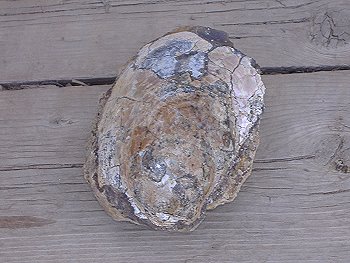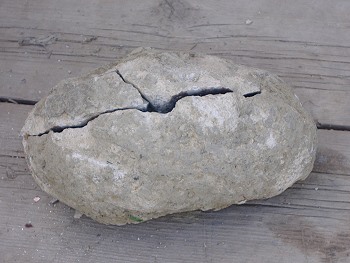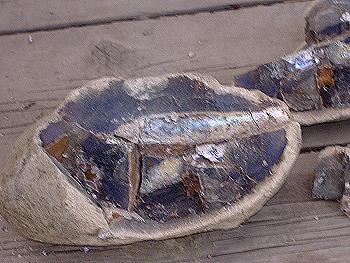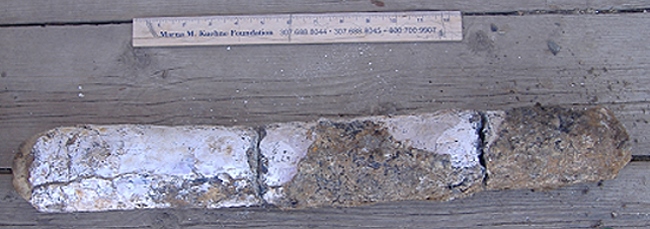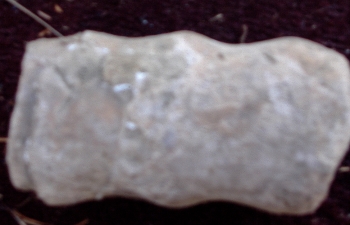|
Mystery Fossil
|
|
Data:
Hi, I was wondering if you could help me identify these fossils. I have
found literally tons of them in clay stone. They are usually in masses
from 6 inches in diameter to a couple of feet. The first two pictures
are of a clam like species, some still have both halves attached.
These second photos are of a different species that are long and elliptical
cross section, they range in size from less than an inch to 6 inches
or more. The first photo shows the kind of mass they are found in, the
second is of a large specimen found inside the rock.
There are at least three specimens in this mass, probably more. Do you
have any idea what these might be, and why they are in these masses?
Also, both species occur in in the masses together.
Thank you for your time,
Gary
PS: These were found in
N.E. Wyoming, USA. I have found some better specimens of the elongated
species, I will try to e-mail some pictures later this week. Also I
could mail a small specimen to anyone in the US if it would help with
identification. These creatures range in size from pencil sized to as
big as my arm, but I have not yet found a complete specimen.
Send
Ideas to:
Gary
|
| |
|
|
|
|
|
|
|
| |
|
| PS: Here are
some better pictures of the long shell fish, they are definitely shell
fish, as most of them still have shell material on them. They are all
long, elliptical, taper to a point on one end, and have separate chambers
inside (I have found some that have not completely fossilized inside).
Most of the outer shells are smooth, but some are wavy, like corrugated
tin or such, you can see this in the picture of the short piece. The large
specimen is the most complete large one I have found so far, it must have
been very long. |
|
|
|
|
| |
|
|
Identified:
PS
Discussions:
-
The long fossils which Gary shows in his updated pictures are
straight (uncoiled) ammonites, probably Baculites spp. ... Allen
A.
-
Baculites and similar forms can be common upper Cretaceous fossils,
likely to occur with Inoceramus. Inoceramus tends to occur in low-oxygen
settings, presumably sitting on the seafloor and getting just enough
oxygen while very little was able to live within the seafloor (
e.g., no burrowing bivalves). As the ammonites were active swimmers,
they could swim up where there was more oxygen and would sink to
the bottom when they died. I think there has been some speculation
that ammonites might have been more tolerant of low oxygen than
fish are and thus had an advantage in certain habitats.
In the Cretaceous, there was an arm of the ocean extending from
the Gulf of Mexico up the present-day Great Plains and the eastern
part of the Rockies (which weren't around yet) all the way to the
Arctic Ocean. As a relatively shallow and enclosed ocean, there
was often opportunity to get a bit stagnant. The dark color of the
rocks that the fossils are in suggests lower oxygen levels. ...David
C.
Discussions:
-
I think these are "nodules". They are formed when
organic materials which can be anything from a nudibranch to a fish,
form an oxygen-deprived ("anoxic") layer of sediments
around them as they decay, since the decay process uses up the available
O2. In the resulting spheroid or oblong anoxic region, sulphates
are often deposited, which results in the very dark interior of
the structure. When the sediment is turned to stone, these regions
form nodulules - areas of higher density and greater durability
centered around the original piece of decayed organic matter which
started the process in the first place. So, if you wish to find
fossils in them, simply crack them down the center of the longest
axis - sometimes the outline of the beastie is stil to be found
inside! ...Ross M.
-
The larger masses (bottom two pictures) are indeed nodules or
concretions. Various other minerals besides sulfides may occur in
them. Sometimes they form by other processes besides having a fossil
in the middle.
http://www.wsgs.uwyo.edu/
is one source of geological information about Wyoming; also try
university geology departments. Determining the age of the fossils
will help a lot in narrowing down the options. The large bivalve
in the second photo is shaped somewhat like an inoceramid,
a group of medium to very large bivalves that were particularly
common in the Cretaceous. I've seen them in some beds in Colorado,
so I think there would be places in Wyoming to expect them as well.
There are freshwater and marine beds of various ages in Wyoming,
though, so there are many possibilites.
If you are able to find a specimen showing the hinge of the shell,
that would be helpful in getting a better identification. ...Dr.
David C.
- All ammonids except for straight ammonid, which is probably Baculites
sp.
|

